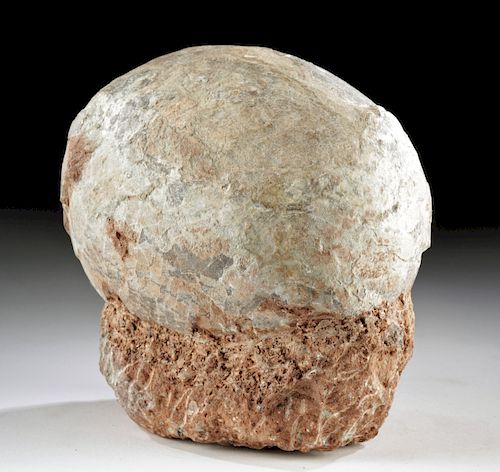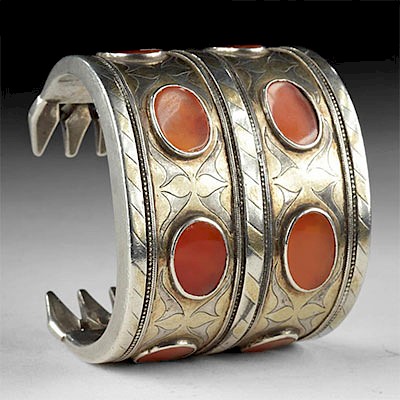Large Chinese Sauropod Dinosaur Egg
Lot 93b
About Seller
Artemis Fine Arts
686 S Taylor Ave, Ste 106
Louisville, CO 80027
United States
Selling antiquities, ancient and ethnographic art online since 1993, Artemis Gallery specializes in Classical Antiquities (Egyptian, Greek, Roman, Near Eastern), Asian, Pre-Columbian, African / Tribal / Oceanographic art. Our extensive inventory includes pottery, stone, metal, wood, glass and textil...Read more
Categories
Estimate:
$1,200 - $1,800
Absentee vs Live bid
Two ways to bid:
- Leave a max absentee bid and the platform will bid on your behalf up to your maximum bid during the live auction.
- Bid live during the auction and your bids will be submitted real-time to the auctioneer.
Bid Increments
| Price | Bid Increment |
|---|---|
| $0 | $25 |
| $300 | $50 |
| $1,000 | $100 |
| $2,000 | $250 |
| $5,000 | $500 |
| $10,000 | $1,000 |
| $20,000 | $2,500 |
| $50,000 | $5,000 |
| $100,000 | $10,000 |
| $200,000 | $20,000 |
About Auction
By Artemis Fine Arts
Aug 6, 2019
Set Reminder
2019-08-06 11:00:00
2019-08-06 11:00:00
America/New_York
Bidsquare
Bidsquare : VARIETY SALE | Antiquities & Ethnographic Art
https://www.bidsquare.com/auctions/artemis-gallery/variety-sale-antiquities-ethnographic-art-4326
Around the world & back in time - be amazed at the treasures you will find. Antiquities from Egypt, Greece, Italy and the Near East, Asian, Pre-Columbian, African / Tribal / Oceanic, Native American, Spanish Colonial, Russian Icons, Fine Art, much more! All categories, all price ranges... Artemis Fine Arts info@artemisfinearts.com
Around the world & back in time - be amazed at the treasures you will find. Antiquities from Egypt, Greece, Italy and the Near East, Asian, Pre-Columbian, African / Tribal / Oceanic, Native American, Spanish Colonial, Russian Icons, Fine Art, much more! All categories, all price ranges... Artemis Fine Arts info@artemisfinearts.com
- Lot Description
East Asia, China, Cretaceous Period, ca. 145 to 66 million years ago. A round, fossilized dinosaur egg from a red sandstone formation. The shell structures are nicely preserved. The round shape tells us that this egg belonged to an herbivorous dinosaur, a member of the sauropod family. Although it looks huge compared to many modern eggs, it is mid-sized for a dinosaur - the largest sauropod eggs are twice this size (and yielded animals who could grow to be nearly a hundred tons!). The Auca Mahuevo site in Argentina contains the best known excavated sauropod egg clutches, and from there we know that they laid 20-40 eggs in sandy depressions that served as their nests. They did not cover them in sand or vegetation; instead, they relied on the sun and proximity to other eggs to incubate them. It is amazing to realize that an egg this size could grow a massive animal - but studies on bones have shown that juvenile sauropods grew as much as two tons per year. Footprints give us evidence that sauropod parents kept a close eye on their offspring after they hatched. Size: 6.1" W x 5.75" H (15.5 cm x 14.6 cm)
Provenance: private southwestern Pennsylvania, USA collection
All items legal to buy/sell under U.S. Statute covering cultural patrimony Code 2600, CHAPTER 14, and are guaranteed to be as described or your money back.
A Certificate of Authenticity will accompany all winning bids.
We ship worldwide and handle all shipping in-house for your convenience.
#148037Shell is fragmentary as shown and has been repaired in a few places. It is partially preserved in its matrix. Form is still clear.Condition
- Shipping Info
-
All shipping is handled in-house for your convenience. Your invoice from Artemis Gallery will include shipping calculation instructions. If in doubt, please inquire BEFORE bidding for estimated shipping costs for individual items.
-
- Buyer's Premium



 EUR
EUR CAD
CAD AUD
AUD GBP
GBP MXN
MXN HKD
HKD CNY
CNY MYR
MYR SEK
SEK SGD
SGD CHF
CHF THB
THB
















